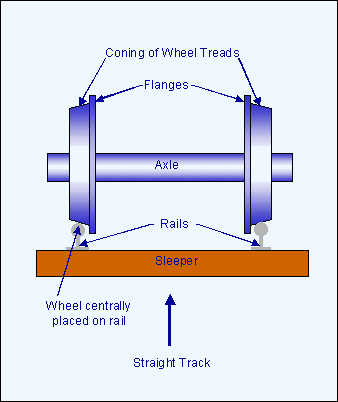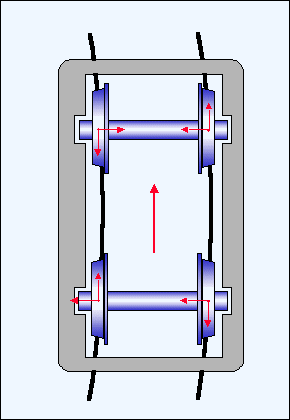A short description of the principles of the wheel/rail interface. Reproduced from http://www.railway-technical.com/whlbog.shtml
The Wheel on the Rail
Railway wheels sit on the rails without guidance except for the shape of the tyre in relation to the rail head. Contrary to popular belief, the flanges should not touch the rails. Flanges are only a last resort to prevent the wheels becoming derailed - they're a safety feature. The wheel tyre is cone-shaped and the rail head slightly curved as shown in the following diagram (Fig 1). The rails are also set at an inward angle.
Ideally, the wheel profile should be determined by agreement between the railway infrastructure owner and the rolling stock owner. Of course, it varies from place to place but it is rarely a simple angle. It's usually a carefully calculated compound form. With respect to the rail angle, in the UK it is set at 1 in 20 (1/20 or 0.05). In the US and France it's usually at 1/40. An excellent series of articles on the wheel rail interface is available in the online magazine 'The Interface Journal'.

Fig 1:
The shape and location of wheels and rails on straight track.
This diagram is exaggerated to show the principle of the wheel/rail interface on straight track. Note that the flanges do not normally touch the rails.
On curved track, the outer wheel has a greater distance to travel than the inner wheel. To compensate for this, the wheelset moves sideways in relation to the track so that the larger tyre radius on the inner edge of the wheel is used on the outer rail of the curve, as shown in Fig 2.

Fig 2:
The location of the wheels in relation to the rails on curved track.
The inner wheel uses the outer edge of its tyre to reduce the travelled distance during the passage round the curve. The flange of the outer wheel will only touch the track if movement of the train round the curved rail is not in exact symmetry with the geometry of the track. This can occur due to incorrect speed or poor mechanical condition of the track or train. It often causes a squealing noise. It naturally causes wear.
There will always be some slippage between the wheel and rail on curves but this will be minimised if the track and wheel are both constructed and maintained to the correct standards. Nevertheless it causes wear and tear.
Bogies
A pair of train wheels is rigidly fixed to an axle to form a wheelset. Normally, two wheelsets are mounted in a bogie, or truck as it is called in US English. Most bogies have rigid frames as shown below (Fig 3).

Fig 3:
A standard rigid bogie on curved track.
The bogie frame is turned into the curve by the leading wheelset as it is guided by the rails. However, there is a degree of slip and a lot of force required to allow the change of direction. The bogie is, after all, carrying about half the weight of the vehicle it supports. It is also guiding the vehicle, sometimes at high speed, into a curve against its natural tendency to travel in a straight line.
